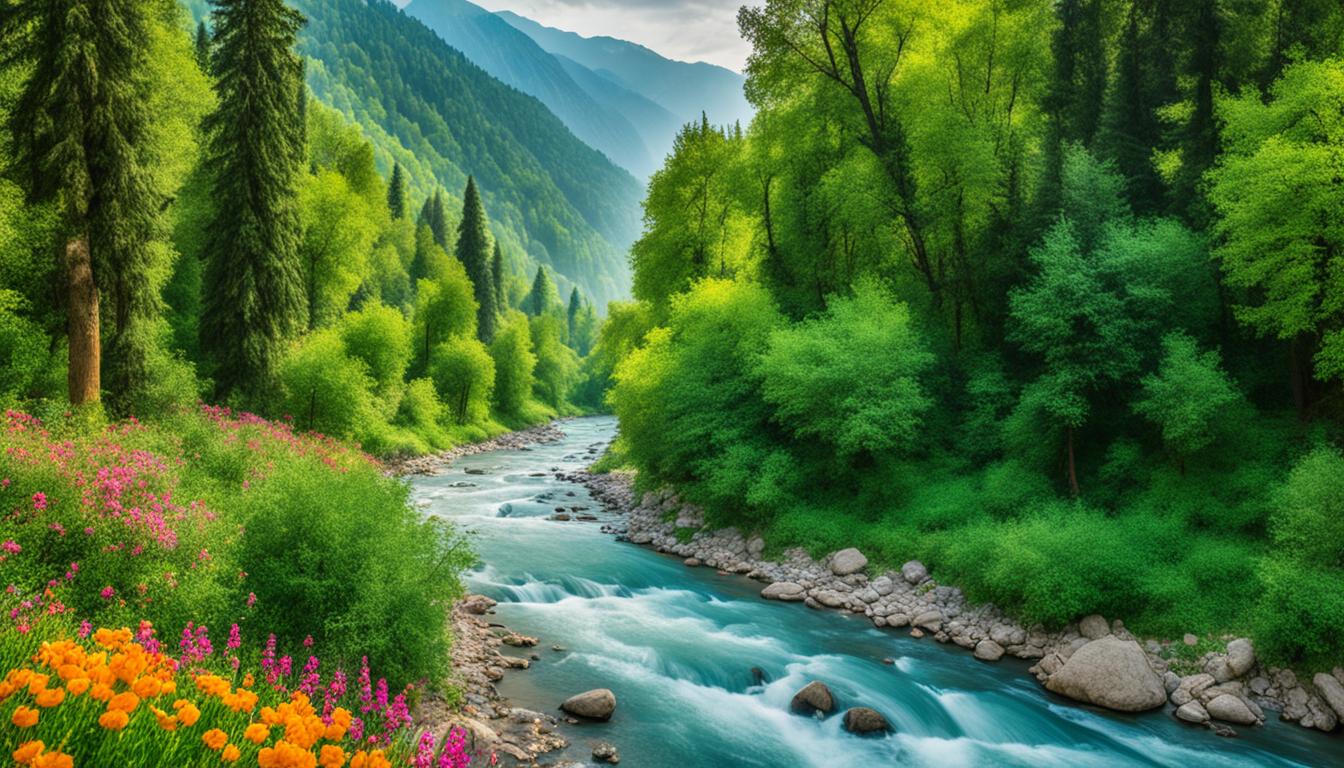Saudi Arabia Biodiversity and the Built Environment
Saudi Arabia, with its vast expanse of 1,969,000 km2, is home to a remarkable diversity of animal and plant species. The country boasts 2,250 species of flowering plants, including 246 that are found nowhere else in the region. Saudi Arabia also has 93 mammal species, 432 bird species, 9 freshwater fish species, 103 reptiles, and 7 amphibians. However, these rich biodiversity face threats such as habitat destruction, over-grazing, over-hunting, pollution, and the expansion of urban areas. Conservation efforts are crucial to protect Saudi Arabia’s biodiversity, and the country has established protected areas and implemented a National Biodiversity Strategy and Action Plan.
Key Takeaways:
- Saudi Arabia is home to a remarkable diversity of animal and plant species.
- Threats to biodiversity include habitat destruction, over-grazing, over-hunting, pollution, and urban expansion.
- Conservation efforts, such as protected areas and the National Biodiversity Strategy and Action Plan, are crucial to safeguard Saudi Arabia’s biodiversity.
- Implementing biophilic design in Riyadh can enhance sustainability and livability.
- Preserving biodiversity contributes to sustainable development and improves the quality of life for residents.
Flora of Saudi Arabia
Saudi Arabia is home to a diverse array of plant life, with approximately 2,250 species of flowering plants. Among these, there are 246 regionally endemic species exclusive to the country. The flora of Saudi Arabia plays a crucial role in the country’s ecosystems and provides essential ecological services. It includes a variety of forms, colors, and adaptations, reflecting the diverse range of habitats found throughout the country.
Medicinal plants are also abundant in Saudi Arabia and have been used for centuries in traditional remedies. The rich botanical diversity of Saudi Arabia offers a treasure trove of plant species with medicinal properties. These plants have long been utilized by local communities for their healing properties, treating various ailments and promoting well-being. The traditional knowledge associated with these medicinal plants is a valuable cultural heritage that deserves recognition and preservation.
Unfortunately, the flora of Saudi Arabia faces numerous threats. Habitat destruction due to urban expansion, agricultural practices, and over-grazing puts many plant species at risk. These activities disrupt the delicate balance of ecosystems and lead to the loss of valuable plant diversity. Conservation efforts are crucial to mitigating these threats and ensuring the survival of Saudi Arabia’s unique botanical heritage.
The botanical diversity of Saudi Arabia is visually captivating. From the vibrant wildflowers that carpet the desert after rainfall to the majestic date palms that dot the landscape, the flora of Saudi Arabia offers a feast for the eyes. The distinct adaptations of plants to survive in arid environments, such as succulent leaves and deep-reaching root systems, are a testament to the resilience of nature.
The diverse flora of Saudi Arabia is not only a source of beauty but also a wellspring of ecological services. Plants play a vital role in carbon sequestration, soil stabilization, and maintaining the water cycle. Protecting the flora of Saudi Arabia is not just about preserving aesthetics; it is about safeguarding the very foundations of our ecosystems.
In conclusion, the flora of Saudi Arabia is a precious natural heritage that should be cherished and protected. The botanical diversity, including numerous plant species with medicinal properties, contributes to the ecological balance and cultural richness of the country. Conservation efforts are essential to safeguarding this diversity for future generations and ensuring the continued provision of invaluable ecological services.
Biodiversity Hotspots in Saudi Arabia
Within Saudi Arabia, there are several biodiversity hotspots where the concentration of endemic and endangered plant species is particularly high. These hotspots include mountainous regions, wetlands, and coral reefs. Protecting these areas is crucial for safeguarding the unique plant life found within their boundaries. Notable species found in these hotspots include the Rose of Jericho, Arabian Balsam, Date Palm, and Arabian Jasmine. Preserving the floral diversity of these hotspots is essential for maintaining the ecological balance and promoting sustainable development.
It is fascinating to discover the biodiversity hotspots in Saudi Arabia, where the richness of endemic species flourishes. These areas, characterized by their unique geographical features, offer a haven for plant species that cannot be found anywhere else in the region. The mountainous regions of Saudi Arabia, with their diverse microclimates and varied elevations, are home to a multitude of plant life. The wetlands, on the other hand, provide essential habitats for a wide range of aquatic plants, marsh vegetation, and numerous bird species. The coral reefs, found along the coastline, offer shelter for an array of marine flora. These hotspots are truly biodiversity treasures that deserve our utmost attention and conservation efforts.
Floral Diversity in the Mountainous Regions
The mountainous regions of Saudi Arabia, such as the Asir Mountains and the Sarawat Mountains, are biodiversity hotspots teeming with endemic plant species. These regions exhibit a remarkable range of microclimates, including cooler temperatures, higher rainfall, and varied soil conditions, supporting plant life that is adapted to these particular conditions. This diverse array of habitats within the mountains allows for the coexistence of numerous plant species, resulting in a rich floral tapestry.
The Rose of Jericho (Anastatica hierochuntica) is a fascinating plant endemic to the Asir Mountains. This remarkable plant has the ability to survive extreme desert conditions, appearing as a dry, withered ball during long periods of drought and unfurling its branches and leaves with the arrival of rain. The Arabian Balsam (Commiphora opobalsamum) is another endemic species found in the mountainous regions. The resin of this tree has been used for its medicinal properties for thousands of years by local communities.
The Vitality of Wetlands
The wetlands in Saudi Arabia, including the Al-Hufoof wetlands and the Wadi Al-Disah wetlands, are crucial for biodiversity conservation. These wetland ecosystems provide a haven for a wide variety of plant species, including aquatic plants and marsh vegetation. The dense vegetation found in the wetlands helps to maintain water quality, filter pollutants, and provide habitat for numerous bird species.
The Date Palm (Phoenix dactylifera) is a notable plant species found in the wetland areas of Saudi Arabia. This iconic tree is not only culturally significant but also provides essential resources for both humans and wildlife. The Date Palm has been cultivated for thousands of years for its delicious fruit, and its leaves and fibre are used for traditional crafts.
The Beauty of Coral Reefs
The coral reefs along the coast of Saudi Arabia, particularly in the Red Sea, are biodiverse oases supporting vibrant marine ecosystems. These reefs are home to a stunning array of coral species, as well as a myriad of fish, invertebrates, and underwater flora. Coral reefs provide vital habitats for a wide range of marine life and contribute to the overall health of the oceans.
The Arabian Jasmine (Jasminum sambac) is a fascinating endemic plant species found in the coastal regions of Saudi Arabia. Known for its delightful fragrance, the Arabian Jasmine is a treasured ornamental plant used in traditional perfumes and enjoyed for its beauty.
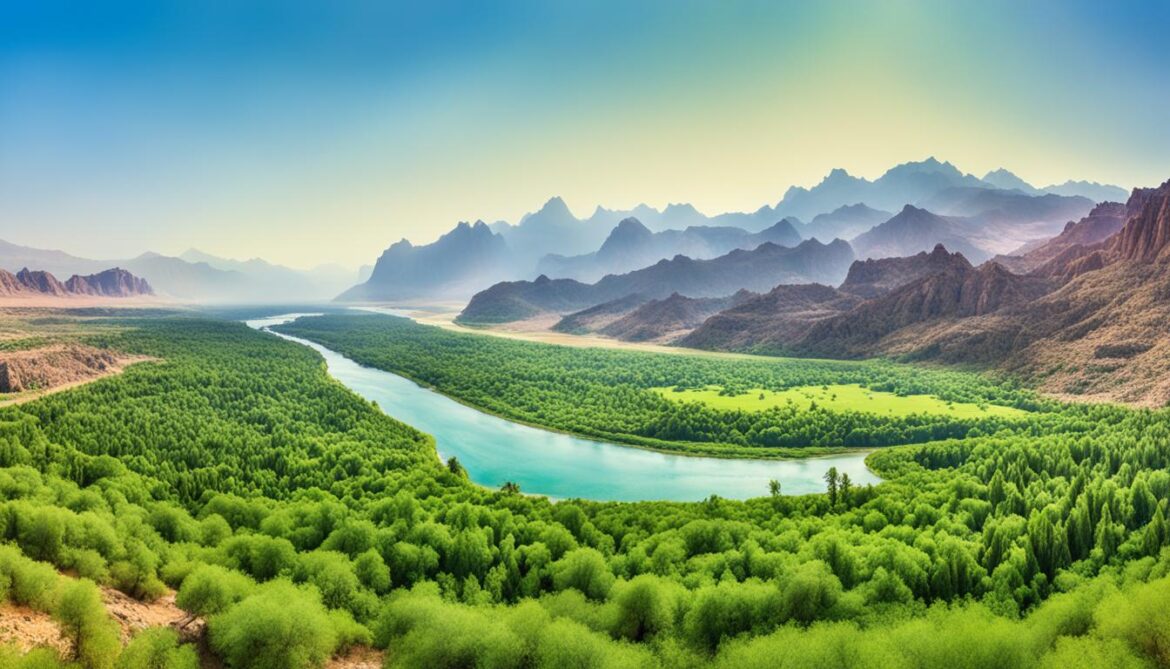
The biodiversity hotspots in Saudi Arabia are crucial for the preservation of unique and irreplaceable plant species. These areas require our utmost protection and conservation efforts to ensure the long-term survival of their floral diversity. By safeguarding these hotspots, we not only preserve the ecological balance but also promote sustainable development that respects and cherishes the invaluable natural heritage of Saudi Arabia.
Fauna of Saudi Arabia
Saudi Arabia is home to a diverse array of fauna, including 93 mammal species, 432 bird species, 9 freshwater fish species, 103 reptiles, and 7 amphibians. These species play vital roles in maintaining the country’s ecosystems and contribute to overall biodiversity.
The mammal species of Saudi Arabia encompass a wide range of habitats and include iconic species such as the Arabian Oryx, Arabian Leopard, and Arabian Gazelle. These mammals are adapted to survive in the country’s arid desert landscapes, showcasing remarkable resilience in the face of extreme conditions.
Protecting and preserving the fauna of Saudi Arabia is crucial for maintaining ecological balance and ensuring the long-term sustainability of the country’s biodiversity.
The bird species of Saudi Arabia are equally diverse, with migratory birds using the country as a crucial stopover along their migration routes. These birds bring color and vitality to Saudi Arabia’s skies, representing both native species and visitors from distant lands.
- The reptiles of Saudi Arabia are an important part of the country’s fauna. From snakes to lizards, they have established themselves in various habitats across the country, adapting to survive in the harsh desert environment.
- These reptiles fulfill essential ecological roles, contributing to pest control and maintaining the delicate balance of the ecosystem.
However, the fauna of Saudi Arabia faces threats such as habitat destruction, over-hunting, and the introduction of invasive species. These factors can disrupt natural ecosystems and endanger the survival of various species.
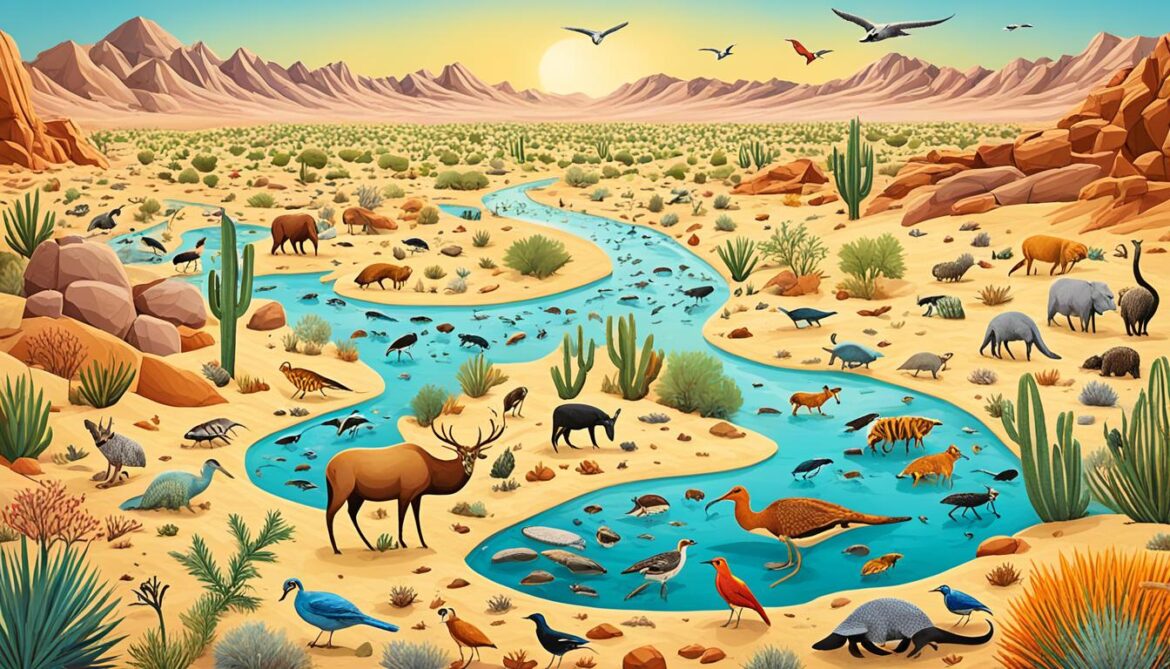
Protecting and preserving the diverse fauna of Saudi Arabia is not only essential for maintaining the natural balance but also crucial for the country’s cultural and ecological heritage. Through conservation efforts and responsible management of natural resources, Saudi Arabia can ensure the long-term survival of its unique and valuable fauna.
Protected Areas in Saudi Arabia
Saudi Arabia is committed to preserving its diverse and precious biodiversity. As part of its conservation efforts, the country has established 15 protected areas spread across its vast expanse. These protected areas cover almost 4% of the country’s surface, providing refuge to a wide range of plant and animal species.
Preserving these habitats is vital for maintaining healthy ecosystems and ensuring the long-term sustainability of Saudi Arabia’s biodiversity.
Each protected area plays a crucial role in the conservation of endemic, endangered, and key species, safeguarding their survival and contributing to Saudi Arabia’s overall conservation objectives. These areas serve as havens for plants and animals that are unique to the region, promoting their protection and recovery.
By designating these protected areas, Saudi Arabia is not only safeguarding its rich biodiversity, but also preserving the natural ecological processes that enable the functioning of complex ecosystems. These areas also serve as valuable educational resources, providing opportunities for research and studies on the diverse flora and fauna found within their boundaries.
The establishment of protected areas is a significant step towards achieving the country’s conservation goals. It reflects Saudi Arabia’s commitment to environmental stewardship and sustainable development, ensuring that future generations can continue to appreciate and benefit from the remarkable biodiversity the country has to offer.
Saudi Arabia’s Protected Areas
| Protected Area | Location | Biodiversity Highlights |
|---|---|---|
| Asir National Park | Asir Region | Endemic plant species, Arabian leopard, Arabian gazelle |
| Masmak Fortress Reserve | Riyadh Region | Flowering plants, Houbara bustard, sand gazelle |
| Farasan Islands | Jizan Region | Coral reefs, endangered sea turtles, dugongs |
| Al-Hafayer Protected Area | Eastern Province | Desert vegetation, Arabian oryx, Nubian ibex |
Threats to Biodiversity in Saudi Arabia
Biodiversity in Saudi Arabia faces significant threats that jeopardize the delicate balance of its ecosystems and the survival of its unique plant and animal species. These threats include habitat destruction and fragmentation, over-grazing, over-hunting, pollution, and urban expansion. Each of these factors contributes to the loss of natural habitats and the disruption of ecological systems.
Habitat destruction and fragmentation are particularly detrimental to biodiversity as they result in the loss of essential resources and shelter for many species. It can occur due to agricultural expansion, infrastructure development, or deforestation. Such activities lead to the degradation and fragmentation of habitats, making it challenging for species to find suitable territories and resources for their survival.
Over-grazing, primarily driven by unsustainable livestock farming practices, has a destructive impact on Saudi Arabia’s ecosystems. Excessive grazing erodes the land and depletes vegetation, preventing natural regeneration and reducing biodiversity. This threatens the habitats and survival of countless plant and animal species.
Pollution poses another significant threat to biodiversity in Saudi Arabia. Pollution from industrial activities, improper waste disposal, and the overuse of chemicals can contaminate soil, water, and air, negatively impacting the health and survival of plants, animals, and aquatic species. The toxic effects of pollution can disrupt reproductive cycles, reduce genetic diversity, and even lead to the extinction of vulnerable species.
Urban expansion is a growing concern in Saudi Arabia, as it encroaches upon natural habitats and fragments ecosystems. The expansion of cities and infrastructure projects leads to the destruction of biodiversity-rich areas, displacing native species and disrupting ecological balances. Urbanization also intensifies pollution and alters natural drainage patterns, further threatening the survival of biodiversity.
In addition to these anthropogenic threats, climate change poses a significant challenge to biodiversity in Saudi Arabia. Rising temperatures and changing rainfall patterns can disrupt delicate ecological balances and negatively impact the distribution and behavior of plant and animal species. Heat stress, water scarcity, and altered habitats pose risks to the survival and reproduction of many species, potentially leading to population declines and local extinctions.
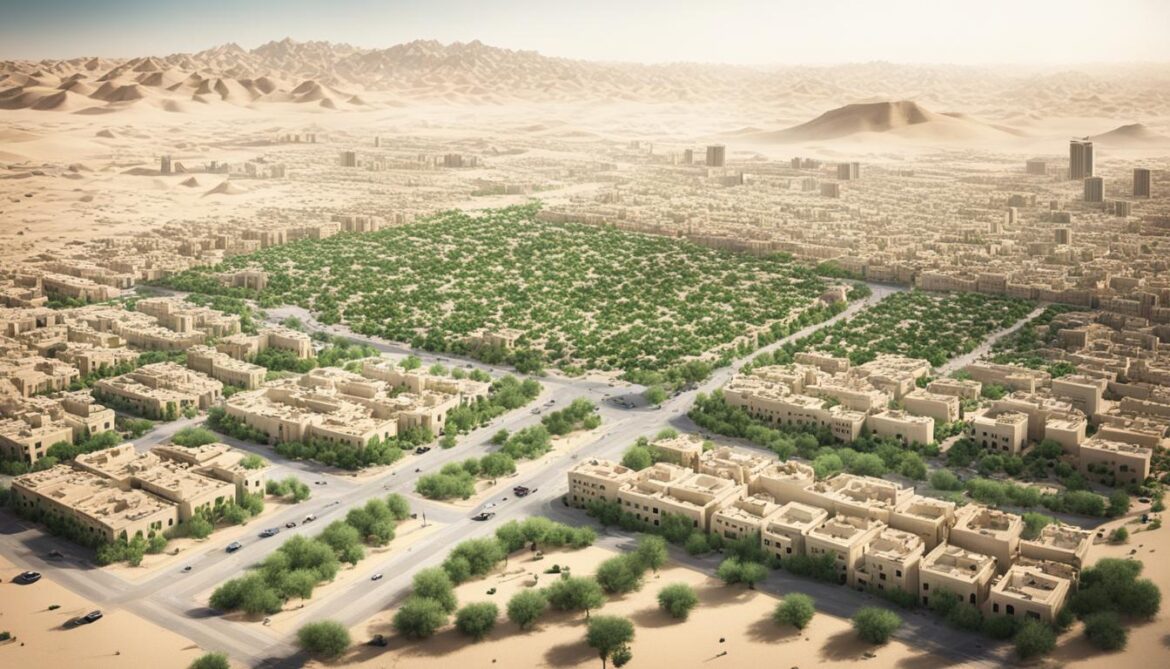
Addressing these threats and implementing proactive measures are paramount to preserve and protect Saudi Arabia’s unique biodiversity. Conservation efforts, sustainable land management practices, wildlife protection initiatives, and pollution control measures are essential to mitigate the detrimental effects of these threats. It is vital to strike a balance between development and environmental conservation to ensure the long-term sustainability of Saudi Arabia’s biodiversity for future generations.
| Threats to Biodiversity | Impact on Biodiversity |
|---|---|
| Habitat destruction and fragmentation | Loss of natural habitats and disruption of ecological systems |
| Over-grazing | Depletion of vegetation and erosion of land, threatening species’ habitats and survival |
| Pollution | Contamination of soil, water, and air, leading to genetic diversity reduction and species extinction |
| Urban expansion | Encroachment on natural habitats, fragmentation of ecosystems, and intensified pollution |
| Climate change | Disruption of ecological balances, altered habitats, and risks to species’ survival and reproduction |
Implementing Biophilic Design in Riyadh
Riyadh, the capital of Saudi Arabia, is embracing biophilic design as a way to create a sustainable and livable city. Biophilic design incorporates nature into architecture and urban planning, creating green spaces, parks, and green corridors. By incorporating elements like rooftop gardens, urban farms, and green spaces, Riyadh can create a vibrant and sustainable city for its residents.
Implementing biophilic design in Riyadh will face challenges such as water scarcity and dust storms. However, the benefits are numerous. Biophilic design can reduce air pollution, enhance biodiversity, improve mental health, and create visually appealing and healthier cities.
“Biophilic design is a powerful tool to reconnect urban dwellers with nature, providing numerous psychological and physiological benefits.”
One of the key advantages of biophilic design is its ability to reduce air pollution. By incorporating more plants and green spaces, Riyadh can mitigate the harmful effects of pollution and improve the overall air quality.
In addition to reducing pollution, biophilic design also promotes biodiversity. By creating green corridors and habitats, Riyadh can provide a sanctuary for various plant and animal species, preserving local ecosystems and promoting ecological balance.
Furthermore, biophilic design has been shown to have positive impacts on mental health. Access to green spaces and natural environments has been linked to reduced stress levels, improved cognitive function, and enhanced overall well-being. Incorporating biophilic elements in Riyadh’s urban design can create spaces that promote relaxation, creativity, and a sense of connection with nature.
Economic Benefits
The implementation of biophilic design in Riyadh can also bring economic benefits. Green spaces and aesthetically pleasing environments have been proven to increase property values and attract tourism. By creating visually appealing and sustainable urban spaces, Riyadh can boost its economy and enhance its reputation as a desirable destination.
Overall, implementing biophilic design in Riyadh is a step towards creating a more livable and sustainable city. By embracing nature in urban planning, Riyadh can enhance the quality of life for its residents, preserve biodiversity, and contribute to a healthier and more environmentally conscious future.
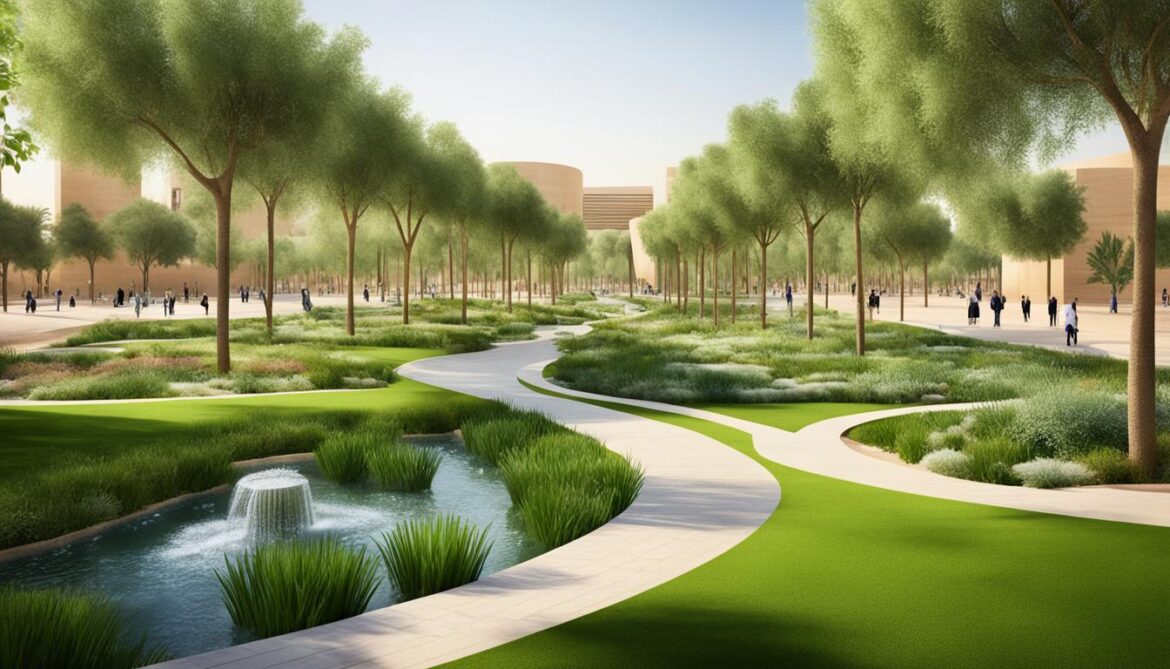
| Benefits of Implementing Biophilic Design in Riyadh |
|---|
| Reduces air pollution |
| Enhances biodiversity |
| Improves mental health and well-being |
| Increases property values |
| Attracts tourism |
Benefits of Implementing Biophilic Design in Riyadh
Implementing biophilic design in Riyadh offers numerous benefits. It can improve air quality, reduce stress levels, increase physical activity, and foster a sense of community and connectedness. Biophilic design embraces the integration of nature into the built environment, creating spaces that nourish and inspire.
Incorporating elements such as natural lighting, indoor plants, and views of green spaces can significantly improve air quality within buildings. Plants act as natural air purifiers, filtering out pollutants and releasing oxygen. This leads to cleaner, fresher air for occupants, promoting better respiratory health and overall well-being.
The presence of nature in indoor spaces has been scientifically proven to reduce stress levels and improve mental health. Natural elements, such as wood textures and flowing water features, create a calming and relaxing atmosphere. These elements help to create a sense of tranquility, making people feel more connected to the environment and reducing feelings of anxiety and tension.
“Biophilic design provides a unique opportunity to enhance the overall quality of life for residents and promotes sustainable living. By incorporating natural elements and green spaces, communities can enjoy the numerous physical and psychological benefits associated with being close to nature.” – Dr. Sarah Collins, Environmental Psychologist
Furthermore, biophilic design encourages physical activity and interaction with the natural environment. By providing access to green spaces and incorporating walking and cycling paths, residents are more likely to engage in outdoor activities. This promotes a healthier lifestyle and improves overall fitness levels.
Biophilic design also plays a crucial role in preserving biodiversity and creating habitats for native flora and fauna. By incorporating green roofs, vertical gardens, and wildlife-friendly landscaping, cities can provide a space for plants and animals to thrive. This contributes to the conservation of local ecosystems and helps to maintain the region’s unique biodiversity.
Additionally, implementing biophilic design principles can bring economic benefits to Riyadh. Improved air quality, beautiful green spaces, and a strong emphasis on sustainability can attract tourists and enhance real estate values. Biophilic design offers a competitive advantage, making Riyadh a more desirable place to live, work, and visit.
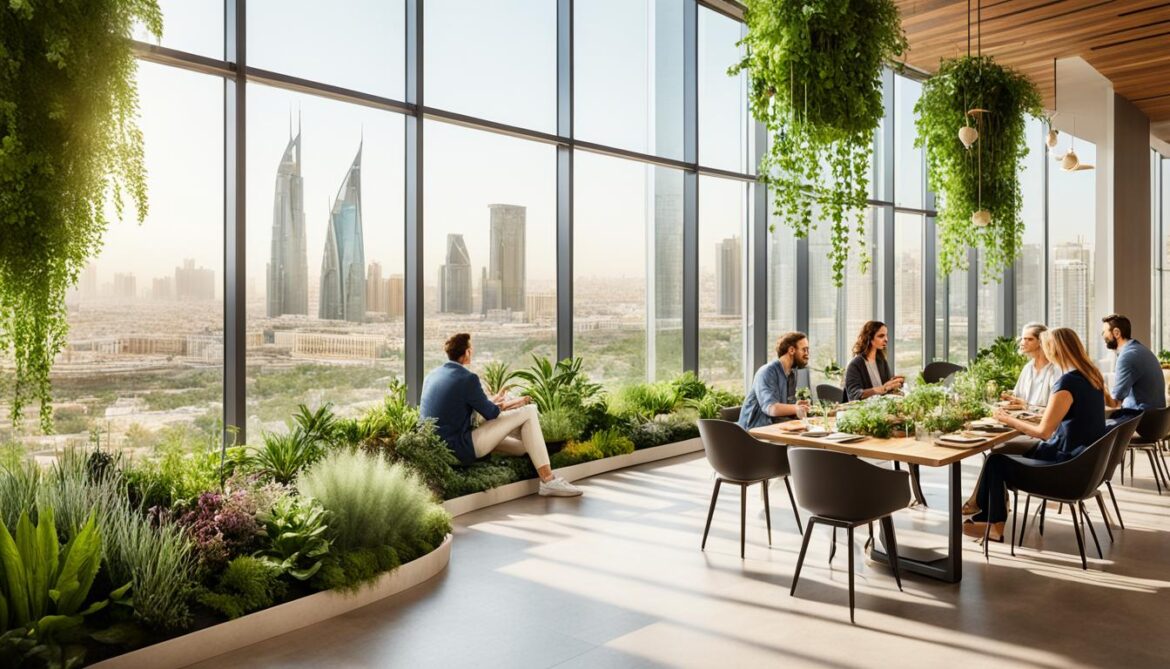
In conclusion, incorporating biophilic design principles in Riyadh can transform the city into a more livable, sustainable, and attractive place. It offers a host of benefits, including improved air quality, reduced stress levels, increased physical activity, community building, and economic opportunities. By embracing biophilic design, Riyadh can become a model city that prioritizes the well-being of its residents and preserves its unique natural heritage for generations to come.
Examples of Potential Projects for Riyadh 2030
In the vision for Riyadh 2030, there are numerous potential projects that could be implemented to incorporate biophilic design principles. These projects could include green infrastructure, natural air and water filtration systems, green roofs, and ample public green spaces. Rooftop gardens, urban farms, and vertical gardens could be integrated into buildings, providing additional insulation and improving air quality. These projects would transform Riyadh into a more sustainable and beautiful city, improving the quality of life for its residents and attracting visitors from around the world.
Green infrastructure plays a vital role in creating a sustainable and resilient city. By integrating green spaces, such as parks, gardens, and urban forests, Riyadh can mitigate the heat island effect, improve air quality, and enhance the overall well-being of its residents. Saudi Arabia’s commitment to sustainable architecture Riyadh is evident in its efforts to incorporate nature into the built environment.
Implementing biophilic design principles in Riyadh is not only an aesthetic choice but also a strategic one. By creating a city that is in harmony with nature, Riyadh can improve the livability of its urban areas, enhance biodiversity, and contribute to the overall sustainability of the region. These projects would not only benefit the environment but also the residents, providing them with access to green spaces, opportunities for physical activity, and a sense of connection to nature.
One potential project for Riyadh 2030 is the creation of a network of green corridors throughout the city. These corridors would connect existing parks and green spaces, providing pedestrians and cyclists with safe and convenient pathways. In addition to their recreational value, green corridors also serve as ecological corridors, allowing wildlife to move freely through the city and promoting biodiversity.
Green roofs are another exciting project that could be implemented in Riyadh. By incorporating vegetation on rooftops, buildings can provide additional insulation, reduce energy consumption, and improve air quality. Green roofs also enhance the visual appeal of buildings, creating a more vibrant and inviting cityscape.
Another aspect of sustainable architecture Riyadh is the integration of natural air and water filtration systems. By incorporating plants and natural filtration mechanisms into the city’s infrastructure, Riyadh can improve the quality of air and water, reducing pollution and promoting a healthier environment for its residents. These systems can be integrated into public spaces, such as squares and plazas, providing both functional and aesthetic benefits.
Potential Projects for Riyadh 2030
| Project | Description |
|---|---|
| Green Infrastructure | Integration of parks, gardens, and urban forests |
| Green Corridors | Network of pathways connecting parks and green spaces |
| Green Roofs | Vegetated rooftops providing insulation and improved air quality |
| Natural Filtration Systems | Integration of plants and natural mechanisms for air and water filtration |
| Public Green Spaces | Creation of ample green spaces for recreational and ecological purposes |
Riyadh’s commitment to sustainable development is evident in the potential projects for Riyadh 2030. By embracing green infrastructure, sustainable architecture Riyadh, and biophilic design principles, the city can create a more vibrant, livable, and sustainable environment for its residents and future generations.
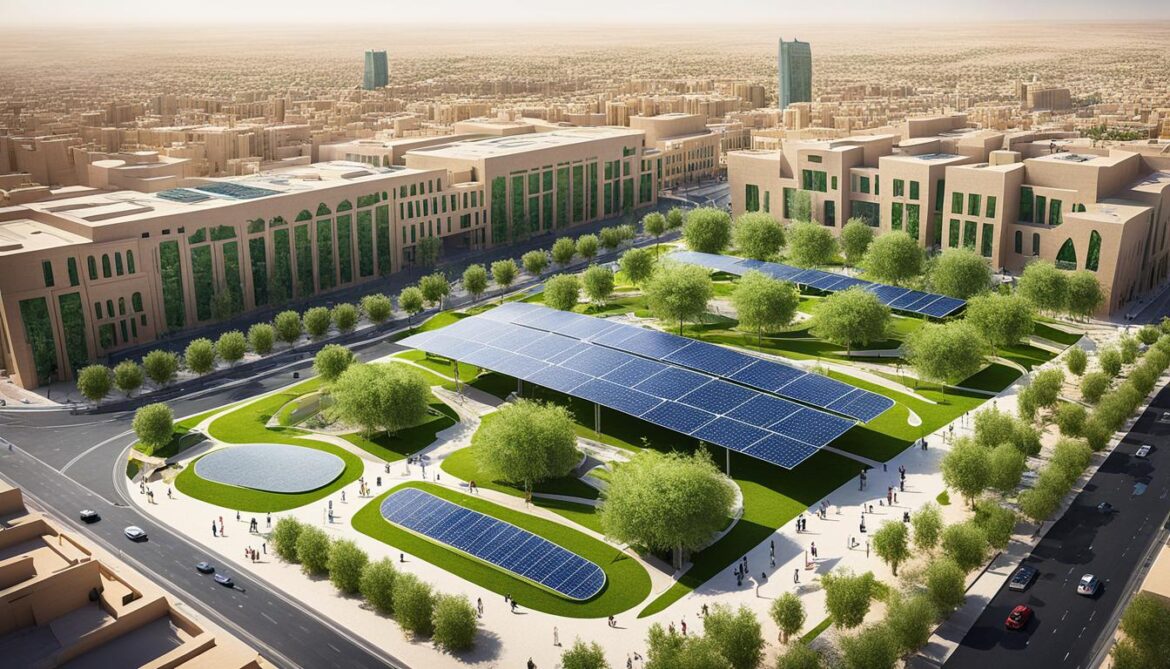
Saudi Arabia’s National Biodiversity Strategy and Action Plan
Saudi Arabia recognizes the value of its biodiversity and is committed to its conservation through the implementation of the National Biodiversity Strategy and Action Plan. This comprehensive plan aims to protect and sustainably manage the country’s diverse ecosystems and species, ensuring their long-term survival.
The National Biodiversity Strategy and Action Plan encompasses a range of goals and strategies, including:
- In-situ and ex-situ conservation: The plan focuses on conserving biodiversity both in its natural habitats and in controlled environments, such as botanical gardens and zoos.
- Conservation and development of various habitats: Saudi Arabia aims to strike a balance between protecting natural habitats and developing sustainable land use practices.
- Regulating access to genetic resources: The plan emphasizes the importance of controlling access to genetic resources to prevent unauthorized exploitation.
- Updating and enforcing environmental legislation: Saudi Arabia aims to strengthen its environmental regulations and ensure their effective enforcement.
- Supporting scientific research: The plan advocates for increased investment in scientific research to expand knowledge of Saudi Arabia’s biodiversity and contribute to its conservation.
- Enhancing environmental education: Saudi Arabia recognizes the importance of educating the public about biodiversity conservation and aims to incorporate environmental education into school curricula and public awareness campaigns.
- Promoting collaboration: The plan encourages collaboration between government agencies, NGOs, and local communities to achieve shared biodiversity conservation goals.
By implementing the National Biodiversity Strategy and Action Plan, Saudi Arabia is taking significant steps towards safeguarding its unique biodiversity and promoting sustainable development. The plan’s multifaceted approach recognizes the importance of conservation, research, education, and collaboration in preserving the natural heritage of the country.

Key Highlights of the National Biodiversity Strategy and Action Plan:
“The National Biodiversity Strategy and Action Plan serves as a roadmap for Saudi Arabia’s biodiversity conservation efforts. By addressing the challenges and implementing the outlined strategies, the country can protect its natural resources for future generations.”
Conclusion
Saudi Arabia’s biodiversity is a valuable natural resource that must be conserved and protected. The country is home to a diverse range of animal and plant species, each playing a vital role in maintaining the ecological balance. However, these species face threats such as habitat destruction, over-grazing, over-hunting, and pollution. To address these challenges and ensure the long-term survival of Saudi Arabia’s remarkable natural heritage, it is crucial to implement biophilic design, establish protected areas, and implement the National Biodiversity Strategy and Action Plan.
By incorporating biophilic design principles in urban planning, such as creating green spaces and green corridors, Saudi Arabia can achieve sustainable development and enhance the quality of life for its residents. The establishment of protected areas will not only serve as refuges for endemic and endangered species but also contribute to overall conservation efforts in the country. Additionally, implementing the National Biodiversity Strategy and Action Plan will further support conservation efforts, scientific research, and environmental education.
Preserving Saudi Arabia’s biodiversity is not only essential for the ecological balance but also for sustainable development. By conserving and protecting the rich biodiversity of the country, Saudi Arabia can maintain its natural heritage for future generations, promote tourism, and continue to benefit from the ecological services provided by these diverse ecosystems. It is through these collective efforts that Saudi Arabia can achieve a harmonious balance between development and conservation, ensuring a vibrant and sustainable future.
FAQ
What is the biodiversity like in Saudi Arabia?
Saudi Arabia is home to a remarkable diversity of animal and plant species, including approximately 2,250 species of flowering plants, 93 mammal species, 432 bird species, 9 freshwater fish species, 103 reptiles, and 7 amphibians.
What are the threats to Saudi Arabia’s biodiversity?
The main threats to Saudi Arabia’s biodiversity include habitat destruction, over-grazing, over-hunting, pollution, and the expansion of urban areas. These activities lead to the loss of natural habitats, disruption of natural balances, and degradation of ecosystems.
How is Saudi Arabia protecting its biodiversity?
Saudi Arabia has established 15 protected areas across the country, covering almost 4% of its surface. These protected areas serve as refuges for endemic, endangered, and key species, promoting their survival and contributing to overall conservation efforts in the country.
What is biophilic design and how is Riyadh implementing it?
Biophilic design incorporates nature into architecture and urban planning, creating green spaces, parks, and green corridors. Riyadh is embracing biophilic design as a way to create a sustainable and livable city, despite challenges such as water scarcity and dust storms.
What are the benefits of implementing biophilic design in Riyadh?
Implementing biophilic design in Riyadh can improve air quality, reduce stress levels, increase physical activity, foster a sense of community and connectedness, preserve biodiversity, and bring economic benefits such as improving real estate values and attracting tourists.
What are some potential projects for implementing biophilic design in Riyadh?
Potential projects for implementing biophilic design in Riyadh include green infrastructure, natural air and water filtration systems, green roofs, ample public green spaces, rooftop gardens, urban farms, and vertical gardens integrated into buildings.
What is Saudi Arabia’s National Biodiversity Strategy and Action Plan?
Saudi Arabia has developed a National Biodiversity Strategy and Action Plan to promote the conservation of biodiversity and the sustainable use of its resources. The plan includes goals and strategies for conservation, the development of various habitats, regulating access to genetic resources, updating and enforcing environmental legislation, supporting scientific research, enhancing environmental education, and promoting collaboration for biodiversity conservation.
Why is the conservation of Saudi Arabia’s biodiversity important?
Preserving Saudi Arabia’s biodiversity is crucial for maintaining healthy ecosystems, ensuring the long-term sustainability of the country’s natural heritage, promoting sustainable development, and enhancing the quality of life for its residents.




